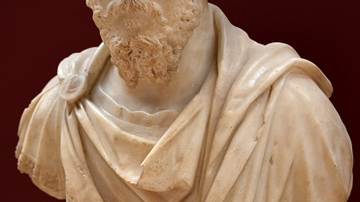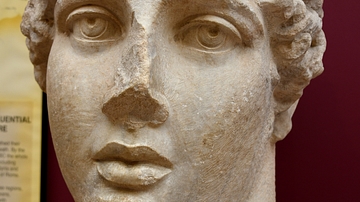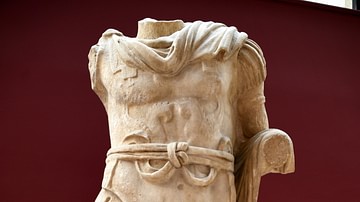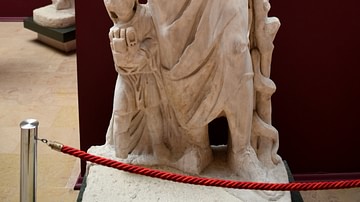Search Images
Browse Content (p. 1107)

Image
Statue of Hermes of Alkamenes from Pergamon
The inscription on the frontal part of the pillar reads, in Greek, "You will recognize the fine statue by Alkamenes, the Hermes before the Gates, Pergamios gave it, know thyself". This is a copy of an original sculpted by the Greek sculptor...

Image
Bust of the Emperor Augustus
The facial features and the scalp hair reflect the typical characteristics of the Roman Emperor Augustus (Octavianus). Marble. Roman Period, 27 BCE to 14 CE. From Pergamon, Bergama, in modern-day Turkey. (Museum of Archaeology, Istanbul...

Image
Bust of Agrippina the Elder from Pergamon
Agrippina the Elder was the daughter of Marcus Vipsanius Agrippa and Julia the Elder, as well as being the spouse of Germanicus. Marble. First half of the first century CE. From Pergamon, Bergama, in modern-day Turkey. (Museum of Archaeology...

Image
Bust of Emperor Marcus Aurelius from Lamunia
Marcus Aurelius was a Roman Emperor and reigned from 161-180 CE. He was the last emperor of the so-called "Five Good Emperors". Marble. Roman Period, 2nd half of the 2nd century CE. From the Village of Kindilli, Lamunia, Bozüyük, in modern-day...

Image
Colossal Head of the Poetess Sappho
The face is oval-shaped and fleshy. The eyes were carefully depicted, with deep cuts. The lips are strong, with grooves. A headband encircles the hair at the front horizontally, at the back vertically, and once more obliquely. This is a type...

Image
Statue of Emperor Nero
The emperor wears his military dress. The head, as well as the right upper limb and the distal part of the left arm were lost. Marble. Roman Imperial Period, first century CE. From Ömerbeyli (Germencik, Aydın), in modern-day Turkey. (Museum...

Image
Statue of Apollo Playing the Cithara from Miletus
Apollo is rendered as a muscular young man. However, the feminine sensuality displayed here is probably caused by his over-emphasized hips. His robe falls below the waist, exposing the external genitals. The fingers (now lost) of the left...

Image
Statue of Asclepius from Cos
Asclepius was the god of medicine and healing. Marble. Hellenistic Period, 2nd century BCE. Copy of an original dating to the 5th century BCE. From Cos, Istankoy, in modern-day Greece. (Museum of Archaeology, Istanbul, Turkey).

Image
Statue of Oceanus from Ephesus
Oceanus (Ogen or Ogenus) was the god of rivers. Marble. Roman Period, 2nd century CE. From Ephesus, Efes, in modern-day Turkey. (Museum of Archaeology, Istanbul, Turkey).

Image
Statue of Poseidon from Byblos
Poseidon was the god of the sea. He is depicted naked, with his mantle thrown over his left shoulder, encircling his left arm; the latter would have held something, probably a tribute, such as a small dolphin. The right leg is supported by...